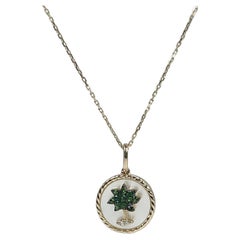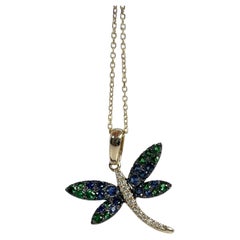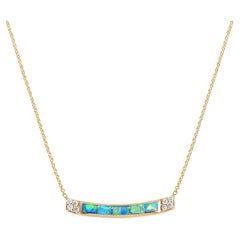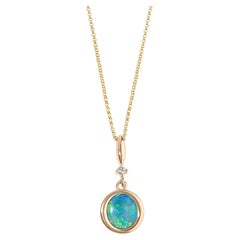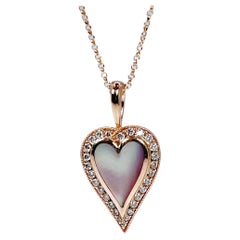Kabana 14kt Pendant
21st Century and Contemporary North American Modern Pendant Necklaces
Diamond, Garnet, 14k Gold, Yellow Gold
21st Century and Contemporary North American Modern Pendant Necklaces
Diamond, Garnet, Blue Sapphire, 14k Gold, Yellow Gold
2010s American Contemporary Pendant Necklaces
Diamond, Opal, Gold, 14k Gold, Yellow Gold
Recent Sales
2010s American Contemporary Pendant Necklaces
Opal, Diamond, Gold, 14k Gold, Yellow Gold
21st Century and Contemporary North American Modern Pendant Necklaces
Diamond, 14k Gold, Rose Gold
People Also Browsed
Vintage 1980s Contemporary Fashion Rings
Amethyst, Gold, 18k Gold, Yellow Gold
2010s American Contemporary Pendant Necklaces
Diamond, Emerald, Opal, Black Opal, 14k Gold, Yellow Gold
Early 20th Century French Belle Époque More Jewelry
Diamond, Platinum
2010s American Contemporary Hoop Earrings
Diamond, Opal, Gold, 14k Gold, Yellow Gold
21st Century and Contemporary American Modern Band Rings
Emerald, Sapphire, Blue Sapphire, Gold, 18k Gold, Yellow Gold
21st Century and Contemporary American Contemporary Pendant Necklaces
Diamond, Opal, Gold, 14k Gold, Yellow Gold
Antique Early 1900s British Victorian Drop Necklaces
Diamond, Sapphire, Gold, Silver
2010s American Contemporary Bridal Rings
Other, Opal, Diamond, Yellow Gold, 14k Gold, Gold
Antique Early 1900s American Art Nouveau Cocktail Rings
Opal, 14k Gold
21st Century and Contemporary Pendant Necklaces
Diamond, Opal, Gold, 22k Gold, Yellow Gold
2010s American Contemporary Drop Earrings
Turquoise, Gold, 14k Gold, Yellow Gold
21st Century and Contemporary American Modern Drop Necklaces
Turquoise, Yellow Gold, 18k Gold, Gold
Vintage 1980s French Modern Cocktail Rings
White Diamond, Blue Sapphire, Sapphire, 18k Gold, Yellow Gold
2010s American Artist Solitaire Rings
Tourmaline, Gold, 18k Gold, Yellow Gold
Antique 1890s European Victorian Drop Necklaces
Diamond, Opal, 18k Gold, Silver
2010s American Contemporary Drop Earrings
Opal, Gold, 14k Gold, Yellow Gold
The Legacy of Diamond in Jewelry Design
Antique diamond rings, diamond tiaras and dazzling vintage diamond earrings are on the wish lists of every lover of fine jewelry. And diamonds and diamond jewelry are primarily associated with storybook engagements and red-carpet grand entrances — indeed, this ultra-cherished gemstone has a dramatic history on its hands.
From “A Diamond Is Forever” to “Diamonds Are a Girl’s Best Friend,” pop culture has ingrained in our minds that diamonds are the most desired, the most lasting and the most valuable gemstone. But what makes the diamond so special? Each stone — whether it’s rubies, sapphires or another stone — is unique and important in its own right. April babies might claim diamonds for themselves, but just about everyone wants this kind of sparkle in their lives!
There are several factors that set diamonds apart from other stones, and these points are important to our gem education.
Diamonds are minerals. They are made up of almost entirely of carbon (carbon comprises 99.95 percent; the remainder consists of various trace elements). Diamonds are the hardest gemstones, ranking number 10 on the Mohs Hardness Scale. Even its name, diamond, is rooted in the Greek adamas, or unconquerable. The only object that can scratch a diamond is another diamond. Diamonds are formed deep within the earth at very high temperatures (1,652–2,372 degrees Fahrenheit at depths between 90 and 120 miles beneath the earth’s surface) and are carried up by volcanic activity. Diamonds are quite rare, according to the Gemological Institute of America, and only 30 percent of all the diamonds mined in the world are gem quality.
In the 1950s, the Gemological Institute of America developed the 4Cs grading system to classify diamonds: clarity, color, cut and carat weight. Not all diamonds are created equal (there are diamonds, and then there are diamonds). The value of the diamond depends on the clarity (flawless diamonds are very rare but a diamond's value decreases if there are many blemishes or inclusions), color (the less color the higher the grade), cut (how the diamond’s facets catch the light, certain cuts of diamonds show off the stone better than others) and carat weight (the bigger, the better).
When you start shopping for a diamond engagement ring, always prioritize the cut, which plays the largest role in the diamond's beauty (taking the time to clean your diamond ring at least every six months or so plays a role in maintaining said beauty). And on 1stDibs, a range of buying guides can be found for those in the market for antique engagement rings, vintage engagement rings or Art Deco engagement rings.
Shop antique and vintage diamond rings, diamond necklaces and other extraordinary diamond jewelry on 1stDibs.
Finding the Right Pendant-necklaces for You
Whether you’re layering multiple jewelry pieces or opting for a single strand, vintage pendant necklaces are versatile accessories that can elevate your casual wear as easily as they can add a creative flourish to your formal attire.
The earliest jewelry was less about accessorizing than it was about wearers arming themselves with amulets. In Ancient Egypt, some amulets featured a loop so that they could be strung around one’s neck. While rubies have long been one of the few gemstones that can give diamonds a run for their money, members of some ancient civilizations valued the stones from the get-go, donning ruby pendants as well as other stones with the belief that these adornments would bring protection, healing powers or strength. Today, we still wear our charm bracelets and charm pendants around our necks for good luck.
Later, pendant necklaces, like most fine jewelry, were worn strictly by royalty or the upper class and conferred wealth and prestige. This changed over time, thankfully, as wearing jewelry became more widespread, a democratized means of personal expression.
During the 18th and 19th centuries, pendant necklaces evolved from their status as spiritual amulets, but the jewels still carried deep personal significance. Victorian pendants, in particular, were part of the “mourning jewelry” tradition. Wearers would embed their pendants with locks of hair from a deceased loved one as a way of grieving in the wake of a loss. In the case of cameo jewelry, some pendants were even decorated with miniature hand-carved portraits in a detailed raised relief. Today, portraiture is still a characteristic of many of the hand-carved pendant necklaces offered by Italian jewelry house Scala Gioielli.
Luxury fine jewelry brands such as Cartier, BVLGARI and David Yurman offer their own unique interpretations of the cherished accessory, embellishing platinum or gold pendant necklaces with diamonds, sapphires and other stones.
On 1stDibs, find an extraordinary range of vintage pendant necklaces and other necklaces today.
- Where is Kabana jewelry made?1 Answer1stDibs ExpertApril 5, 2022Kabana jewelry is made exclusively in New Mexico, USA. Founded in 1975 by inlay master Stavros Eleftheriou, Kabana’s signature look includes meticulously sculpted gemstones inlaid into channels to form a dome. On 1stDibs, shop a collection of Kabana jewelry from top sellers worldwide.
